The concepts covered in this factsheet go beyond those seen in secondary school. It is intended as a supplement for those who are curious to find out more.
Long before the arrival of Europeans, South America was inhabited by a multitude of peoples. From the territory occupied by the present-day United States to the southernmost point of South America, many indigenous nations lived and developed, some even forming empires.
The peoples of South America included the Aztecs, the Mayas and the Incas.
| |
Territory |
Lifestyle |
Social structure |
Home |
Livelihood activity(ies) |
|
Aztecs |
Northern Mexico | Sedentary | Empire | Houses, temples, palaces, aqueducts | Agriculture |
| Mayas | Southern Mexico, Guatemala, Honduras | Sedentary | Hierarchical villages | Houses, palaces, pyramids, temples, fortifications | Agriculture |
| Incas | Peru, Ecuador, Colombia, Bolivia, Argentina, Chile | Sedentary | Empire | Stone houses, palaces, fortresses, etc. | Agriculture, élevage, pêche |
This sedentary people made their living from agriculture in northern Mexico. The Aztecs managed to live thanks to a special technique that enabled them to grow crops in swamps.
The Aztecs founded a great empire in Mexico. Their history is complex, as is the knowledge they developed. Aztec culture was heavily influenced by the culture of the Toltecs. The Toltecs ruled this region until the 8th century. This tribe worshipped the Sun, the Moon and the Quetzalcóatl (the Feathered Serpent). Although the civilisation collapsed suddenly, all American civilisations have been influenced by Toltec culture and religion.
The Aztecs were one of the tribes of the Mexicas. The Aztecs were originally a tribe of around 1,000 people from northern Mexico. This tribe was rejected by all the other tribes. Migration began around 1168 in search of a new capital.
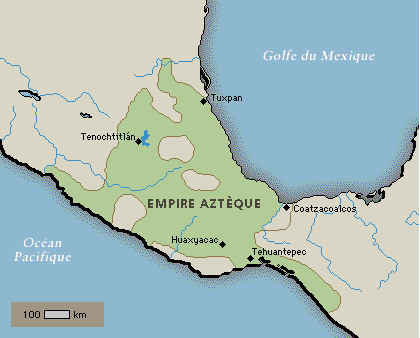
The territory covered by the Aztec Empire
Note: English image coming soon
The Aztecs founded the city of Tenochtitlán, which later became Mexico City, in the middle of a marshy plain in 1350, after seeing an eagle swoop down on a snake. This image still marks the myths surrounding the founding of Mexico.
The Aztecs established their power in the region by appointing a king. The people became increasingly warlike and slowly took control of the whole region. There were frequent wars with other tribes. However, it was periods of peace that enabled them to consolidate their society, which was inspired by the religious myths of the Toltecs. The Aztec people became dominant and warlike. Religion also supported this warlike vision. Their power was consolidated by a strong alliance with two other tribes.
The wealth of the Aztec Empire increased as the subjugated peoples brought their treasures to the capital. This wealth made it possible to undertake major works such as the construction of temples and an aqueduct.
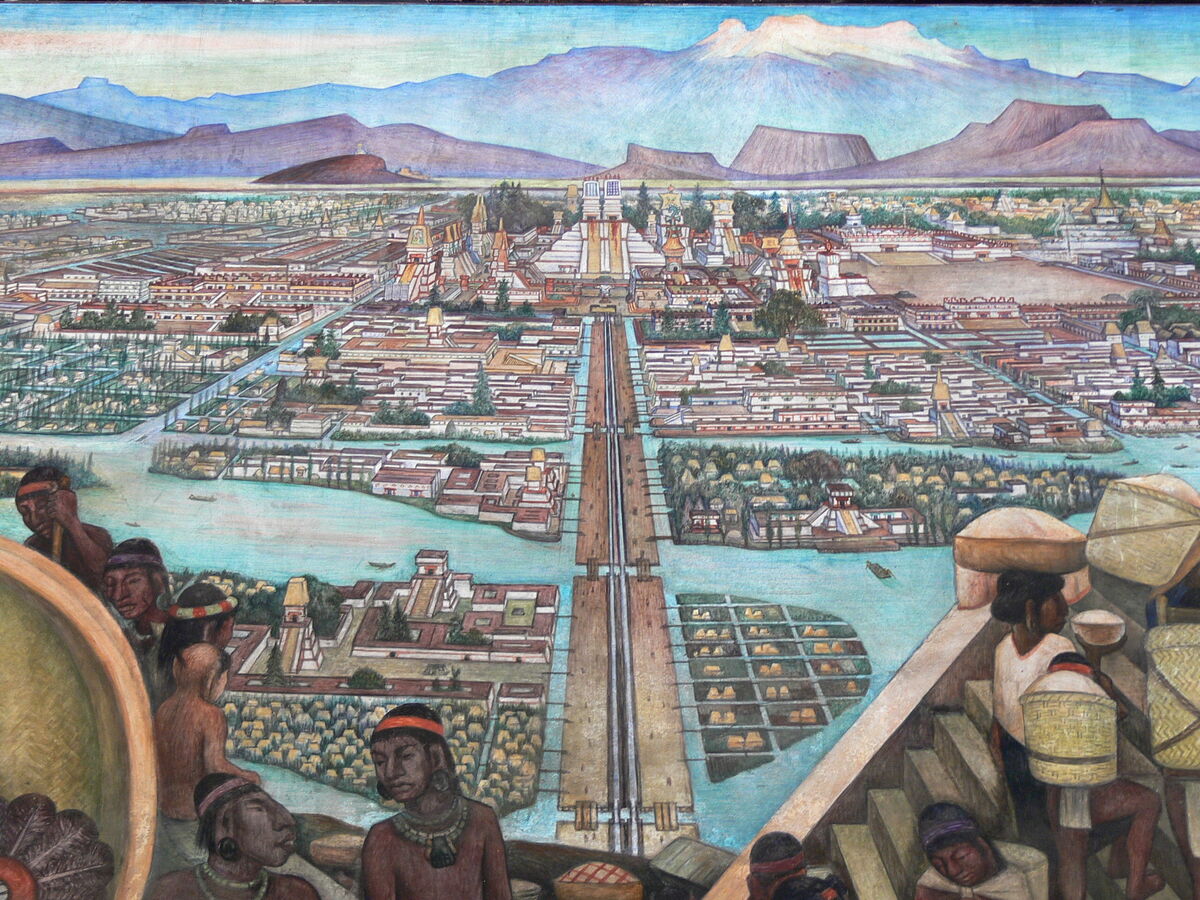
A representation of what Tenochtitlán could have been
The territory, a victim of natural disasters (locusts, frosts, floods, droughts), is extremely difficult to manage and suffers from a shortage of soldiers. However, the great city of Tenochtitlán continued to develop. It was well organised and boasted many treasures.
Aztec civilisation was an empire, so it had several emperors. Each emperor enjoyed power emanating from a divine source. His duty to the gods was to protect the people. Many other people were part of the imperial organisation, including administrative councils and army commanders. Several civil servants, such as administrators and the police, were also involved in the smooth running of the empire.
Citizens of the Aztec Empire had to pay annual taxes. These taxes generally consisted of agricultural produce. People who could not offer enough goods had to provide young people as sacrifices. The Aztecs succeeded in creating a strong culture in which information and knowledge were important. This is why they devised a fairly complex writing system, a precise calendar and a numbering system that allowed precise calculations to be made. The Aztecs also created ways of preserving their knowledge.
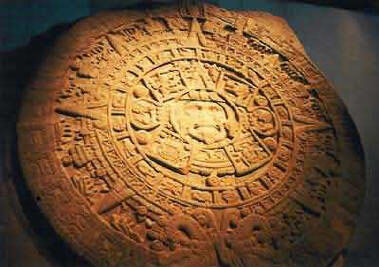
The Aztec calendar
It is mainly thanks to the writings of Bartolomé de Las Casas that we know so much about the Aztec way of life and traditions.
Aztec religion had a strong influence on many aspects of social life. According to the myths, each element (earth, wind and fire) had its own sun. However, these suns died after cataclysms. The same would apply to another sun: the sun of movement. The spiritual vision is therefore rather pessimistic, since it conveys the belief that the Sun is destined to die out. To prevent its death, it must be fed with human blood. It was this idea that justified the many human sacrifices carried out by the Aztecs. Most of those sacrificed were prisoners of war. War was essential in order to carry out enough sacrifices and thus avoid the death of the Sun.
The Aztecs were always at war with a neighbouring state. To ensure the necessary warrior strength, young boys began their military training at the age of 10.
The size of the Aztec capital greatly impressed Europeans and contributed to the creation of the myth of El Dorado. What's more, Europeans arriving in Tenochtitlán were very impressed by the way the city was organised. With a population of 500,000, it is by far the largest city on the continent.
Despite their strength in numbers, the Aztecs had to bow to the Spanish conquistadors. The latter were armed, protected by armour and benefited from the strength of their horses. The Spanish army entered the capital in May 1519. The king immediately submitted to the conquistadors. According to Aztec myths, the end of the solar cycle had arrived and the king saw the Spaniards as messengers of the gods, which explains this rapid submission.
To take the capital, the conquistadors allied themselves with the enemies of the Aztecs. When they set out on their assault, they attacked the nobles and rulers of Tenochtitlán directly. The Aztecs, for their part, did not kill their enemies and were quickly demoralised by the extreme violence of the Spaniards. The city was officially taken by the Spanish in August 1521. It was the end of the Aztec Empire. The empire was destroyed at the height of its power.
Barely 4 years after the Spanish invasion, the entire city was destroyed and rebuilt in Spanish style. There are no more lakes, lagoons or canals. The city was also explored by Cortés.
These indigenous South Americans developed a rich and diverse culture. In their own way, they contributed to the technological development of the time.
The Europeans who arrived in America in the 16th century did not encounter the Mayans. Indeed, by the time they arrived on the new continent, the Mayan civilisation had already died out.
The Olmecs reached their peak between 1200 and 600 BC. They were the first to build major religious centres (ceremonial sites and temples). They were also the first to develop writing symbols and a 260-day calendar. Mayan civilisation began to develop in 2600 BC. The hierarchical government structure was put in place in 300 BC. The Maya did not establish an imperial system as the Aztecs and Incas had done.
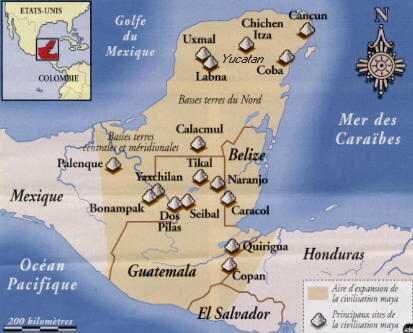
Maya territory
Note: English image coming soon
Mayan culture encompasses 24 different languages. The population is divided into three main geographical areas. All these regions have a tropical climate. The main differences are in relief and soil type. There are volcanic soils at high altitude, well-irrigated central lowlands and arid plateaux where water drainage is underground.
Among the Maya, each city is managed by its own hierarchy. At its height, the Maya civilisation was home to some 20 million people. The main city, Tikal, was home to up to 70,000 people.
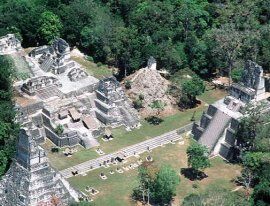
The ruins of Tikal
Each kingdom around the cities is independent. The territory was divided into cities and agricultural territories. These structured kingdoms reached their apogee in 250. The decline of Mayan civilisation occurred in 900. For reasons that remain a mystery, all the Maya gradually left the cities. Around 1200, they were integrated into Toltec society..
There are several possible explanations for the fall of the Maya civilisation. The territory in which the Maya lived was made up of soil that did not retain water, and it is assumed that the Maya cities began to have difficulty obtaining water supplies. These shortcomings in the soil were accompanied by a prolonged drought. The various kingdoms became increasingly short of food and some went to war with each other to conserve their food resources. The Maya gradually forgot their scientific knowledge in favour of their warrior knowledge. However, certain urban centres continued to develop until the Spanish conquest. The abandoned cities were rediscovered by explorers in the 19th century.
Each Mayan city had its own nobility and rulers. These were at the top of the social pyramid. They lived in the cities with the clergy. The common people lived on the outskirts of the towns and worked in agriculture. The economy of the towns was based essentially on agricultural products, more specifically maize, cotton and cocoa.
Several large buildings were erected in the towns. These were made of stone, wood and other materials (sandstone, limestone, marble) for decoration. The Maya built palaces, pyramids (Maya pyramids are among the tallest in the world), temples (located at the top of the pyramids), public squares, steam baths and fortifications. The decorations on the buildings represent episodes in the history of the civilisation. All the buildings are arranged in the city according to astronomical knowledge, the sky map and the alignment of the Sun.
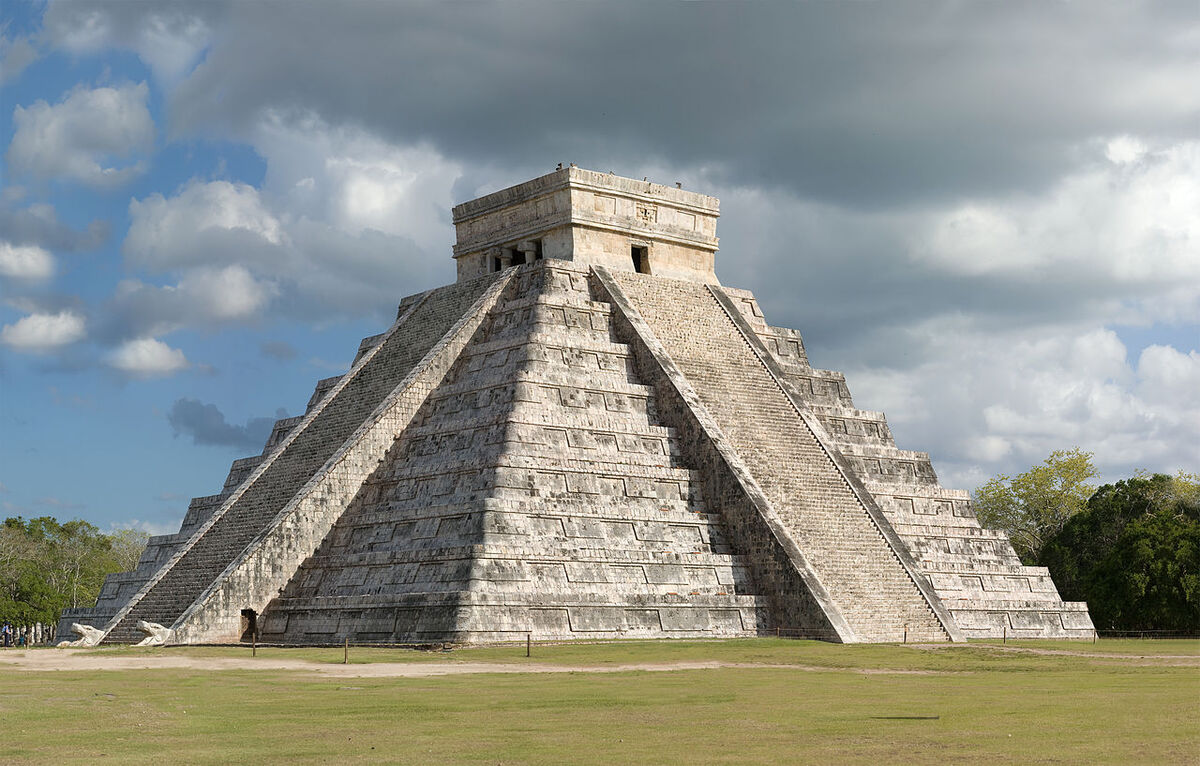
One of the Mayan pyramids
It is assumed that the Maya used slaves, probably prisoners of war, to construct all these buildings. It is also assumed that several architects and craftsmen were trained and hired by the rulers.
Mayan religion is based on the belief that the cosmos influences human existence. It is therefore necessary to pay homage to the gods. According to their beliefs, there is a God who created the gods, who in turn created mankind. Today, most Mayans live in a hybrid faith, a mixture of Mayan and Catholic religions.
The Maya culture developed a great deal of scientific knowledge. This knowledge was based on that of the Olmecs. The Maya had developed a calendar, astronomical observations, hieroglyphic writing, precise architecture, agricultural techniques, methods of conserving and distributing water, and a network of roads through the jungle.
As far as science is concerned, the Maya developed a much more precise calendar than that of the Olmecs. Indeed, theirs comprised 365 days. The Maya also built several astronomical observatories. These observatories were precise enough to predict annual events to within a few seconds.
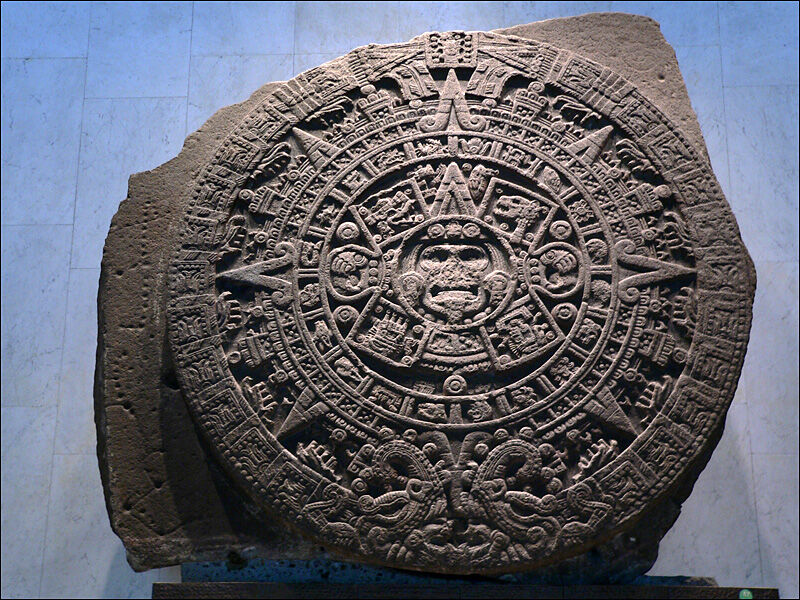
The Mayan calendar
The mathematical system was vigesimal, i.e. based on 20. The mathematical symbols therefore represented numbers from 0 to 20. These symbols were used to perform additions and subtractions, which were useful in trade. The number 20 was important because it represented the number of human fingers and toes.
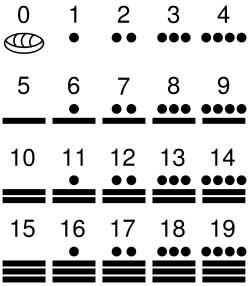
The 20 mathematical symbols
Mayan writing was sufficiently developed and complex for scholars to transcribe knowledge of medicine, botany, history, mathematics and astronomy. Several texts, probably 27, were preserved for quite a long time. However, when Europeans discovered them, they burnt them because they were pagan (non-believers). Today, only 4 of these texts remain.
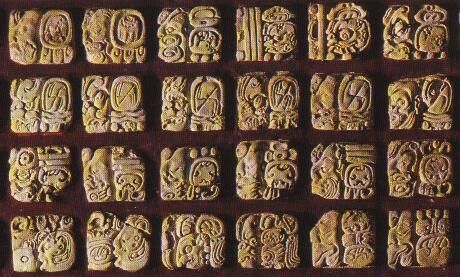
Examples of Mayan hieroglyphs
When the Spanish arrived in Mexico, they first found the ruins of large cities. However, these ruins were inhabited by aborigines. The Spaniards did not understand the link between the ruins they saw, which heralded the presence of a complex civilisation, and the indigenous people they encountered. When they arrived in the few towns that had continued to flourish, the Spanish destroyed them in exactly the same way as they had done the Aztecs.
This civilisation grew from a small warrior tribe into the largest indigenous empire in South America. This theocracy succeeded in imposing its power thanks to its military might.
The Inca civilisation was the largest indigenous civilisation in South America. This immense empire left many traces in terms of its architecture, culture and technical knowledge.
The Inca people were originally a small warrior tribe who lived in the plateau region of Peru. The Incas began migrating to the Cuzco valley in the 12th century. This city was to become the capital of the Inca Empire. As soon as they settled in the region, the Incas quickly subjugated the neighbouring peoples. Their ascendancy continued until the 15th century as they consolidated their domination of the region.
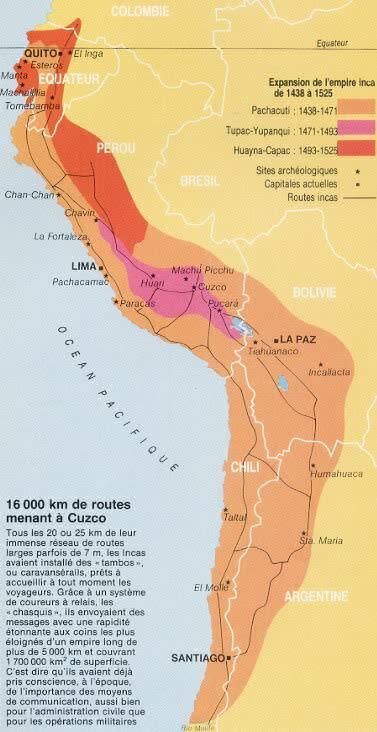
The expansion of the Inca Empire through the road network
Note: English image coming soon
In 1525, the vast Inca territory included the present-day regions of Colombia, Ecuador, Peru, Bolivia and parts of Argentina and Chile. This territory covered no less than 3,500 kilometres from north to south and 800 kilometres from east to west.
The administrative system of the Inca Empire was based on the principles of a theocracy, i.e. a society in which governance was exercised by religious authority. Society was divided into several hierarchical castes. At the very top of the social pyramid was the emperor, who was considered a living god. Surrounding the emperor were the royal family and the aristocracy. Immediately below these were the administrative classes, followed by the lesser nobility. The people, made up of the great mass of craftsmen and farmers, formed the base of the social pyramid.
To make it easier to manage and administer the territory, the empire was divided into 4 major administrative regions. The tight control exercised by the people who managed in the emperor's name helped to keep the empire together. At certain times, the administrators could even decide to move part of the population for economic or political reasons. These people had to obey the directives.
Despite the sheer size of its territory, the empire enjoyed efficient communications. An immense network of paved roads linked all the cities and regions. In fact, 25,000 kilometres of roads allowed pedestrians and llama caravans to travel easily throughout the empire. To ensure that messages were communicated from one region to another, administrators could entrust their messages to professional runners who took it in turns to travel from one area to another. These routes crossed both mountains and deserts.
The longest road measured 2,400 kilometres and was 8 metres wide. This road was lined with trees to provide constant shade for walkers, a canal ran alongside it to provide water, and shelters were located along the road at regular intervals.
Feeding the population was made possible by agriculture and livestock farming. Depending on the region and soil type, the Incas produced potatoes (in the mountains) and maize (in the valleys). Agricultural products included chillies, tomatoes, avocados, coca, rice and guavas. These agricultural products were supplemented by livestock: wild birds, ducks and guinea pigs.
Agricultural techniques (terraces, irrigation canals and cisterns) and food preservation (drying) enabled the Incas to easily meet their food needs, even in times of famine.
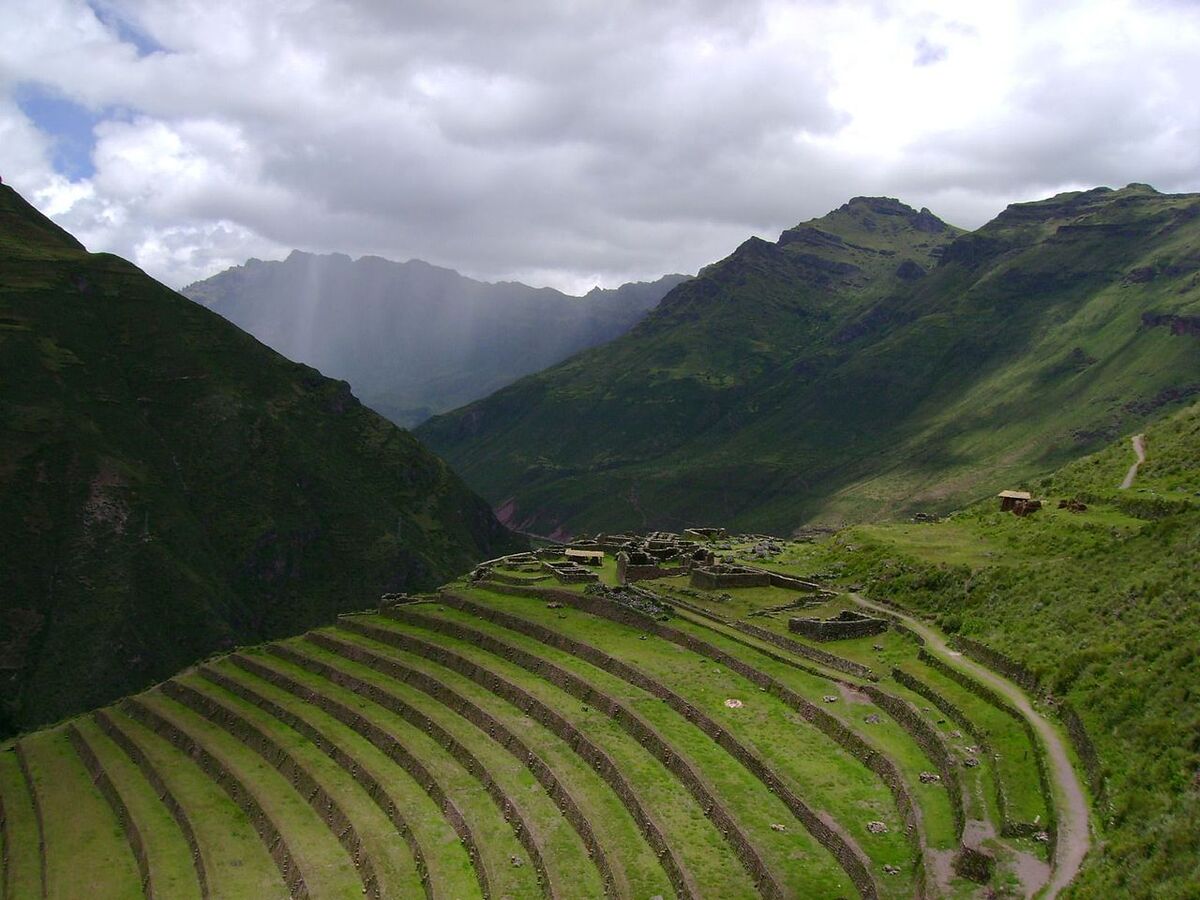
Agricultural terraces allow crops to be grown on more uneven terrain
The role of men in society varied according to caste. The emperor's sons would become the administrators. Other men were responsible for paying taxes, cultivating the land, ploughing, fishing and so on. Some young boys were selected for specific occupations: the most skilful became warriors, the fastest became runners. Some men also became priests or doctors. Doctors were able to treat many illnesses, anaesthetise patients and perform operations and transfusions.
For their part, women played a number of roles: caring for the elderly, educating children, working the land, preparing meals and weaving wool. Women received a strict education and it was the state that decided what role each woman would play. When they reached the age of 16, the most beautiful women became the emperor's wives, while the others were given domestic duties.
According to Inca rites, the Sun is the most powerful star. Other natural elements such as the moon, the stars, the earth, the sea and thunder (although the Incas fear thunder) represent divinities.
Several ceremonies are organised to please the gods. These ceremonies take place in temples with musicians. In addition, before making major decisions, it is important to consult the soothsayers. Again to please the gods, these diviners will sometimes recommend animal sacrifices. They may also recommend sacrificing young women to keep the Sun alive.
Inca temples were generally surrounded by a fortress. The best-known fortress is Machu Picchu. Machu Picchu was so well hidden in the mountains that it was not discovered until 1911. To build temples, palaces and houses, the Incas set stones in a mud mortar.
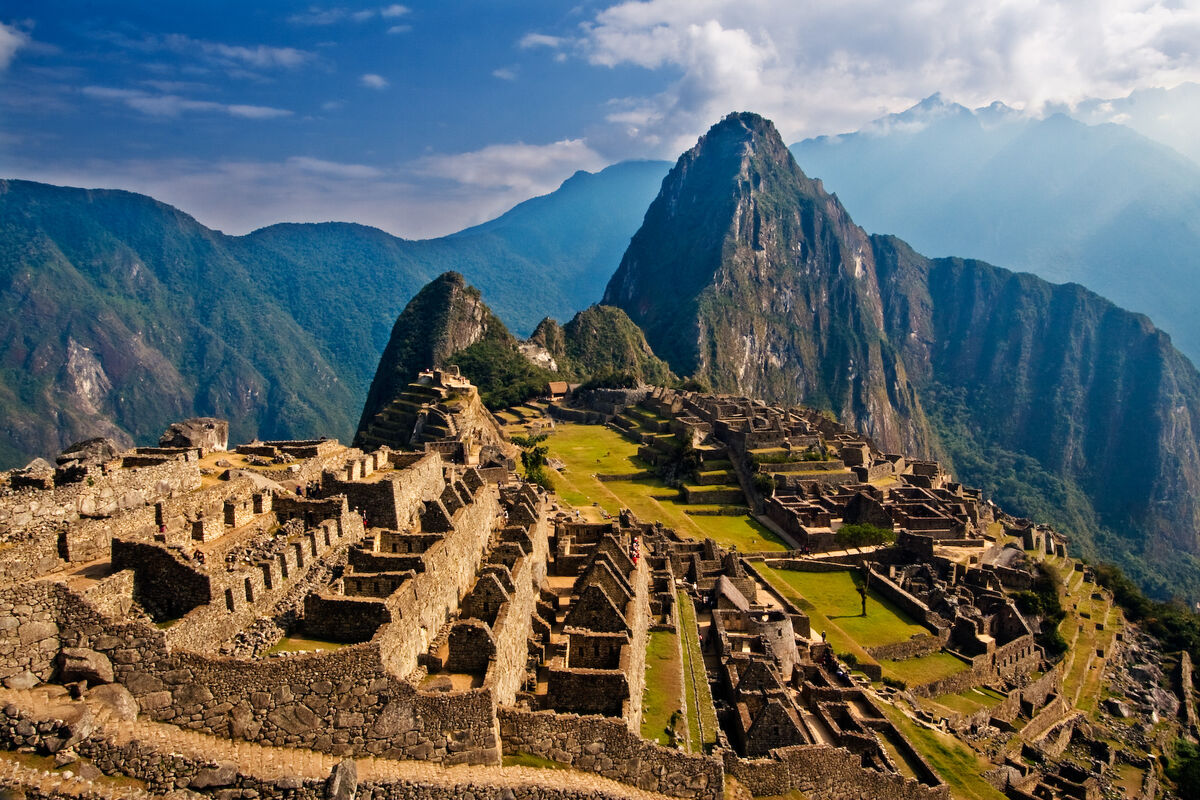
The ruins of Machu Picchu
To build the temples and palaces, the rulers employed stonemasons who used stone or bronze tools as well as mallets and levers.
The houses were rectangular and had only one room. All the houses formed villages with streets and avenues. At the centre of each village were the temple and the municipal buildings. The palace was the most spacious house in the city. As well as houses and palaces, the Incas built a number of other important structures: suspended rope bridges, irrigation canals, aqueducts, etc.
The Incas had no need of slaves despite the great works they undertook. In fact, every citizen had to do compulsory work for the state. These citizens carried out all the construction and development work. In this way, the emperor had unlimited free labour without enslaving individuals.
The empire also had a large and strong army. Thousands of men were part of this army. Not only were they numerous, but they also had efficient, precise and long-range weapons. Despite the strength and power of their civilisation, the Incas had not created a system of writing. Communications were based on a system of knots on woollen strings known as quipu. The type of knot, the type of wool and the colour of the string all played a part in creating the meaning of the code.
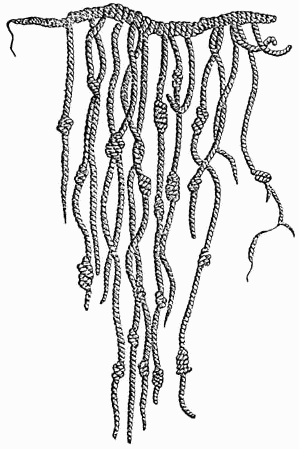
Representation of a quipu
One of the most mysterious aspects of the Inca civilisation is undoubtedly the presence of numerous geoglyphs. These are immense drawings traced on the ground. Discovered in 1930, they are mostly visible from the air. Archaeologists do not yet know how to interpret these symbols or what meaning to give them. These geoglyphs include a wide variety of drawings (around 300), some of which are highly stylised and represent animals, while others are more rudimentary geometric shapes. The most recurrent hypotheses concern the links between these drawings, the rotation of the Sun and agricultural practices.
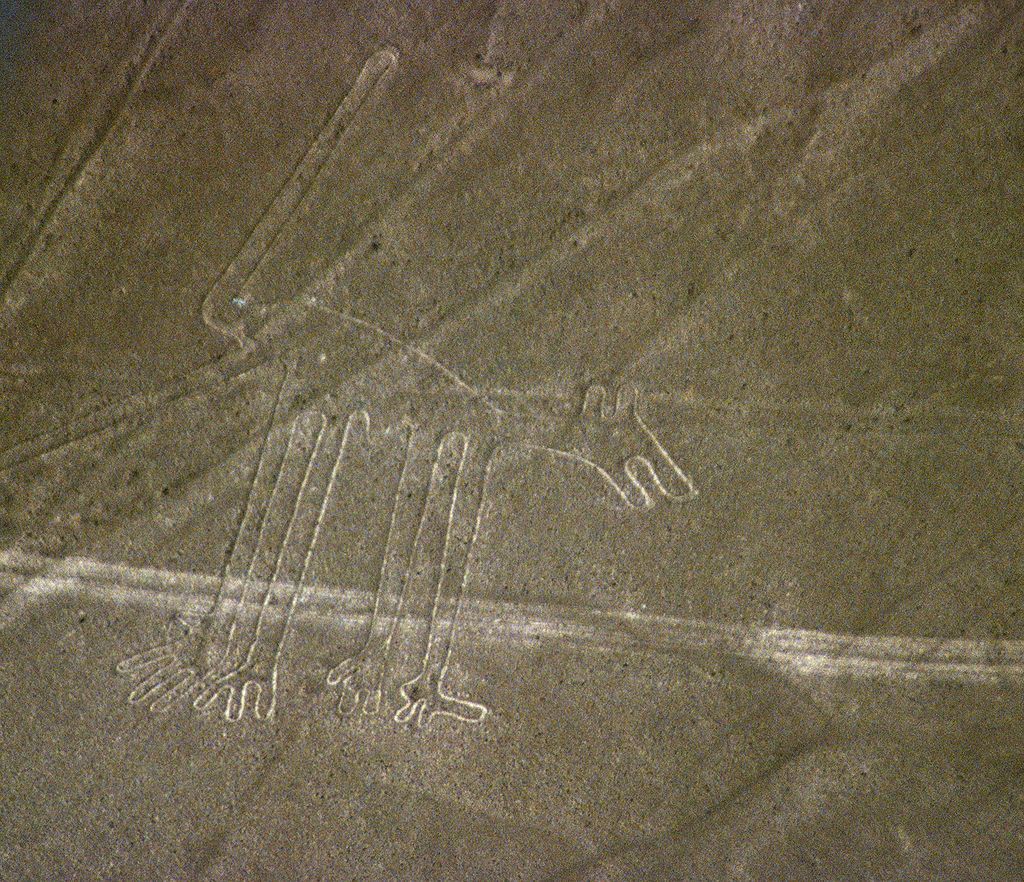
One of the Nazca geoglyphs
By 1525, internal unrest was rife in the empire. The emperor had no successor and the vast territory became more difficult to manage. At the same time, Pizarro entered Inca territory. With just 180 armed men, this conquistador managed to conquer the territory.